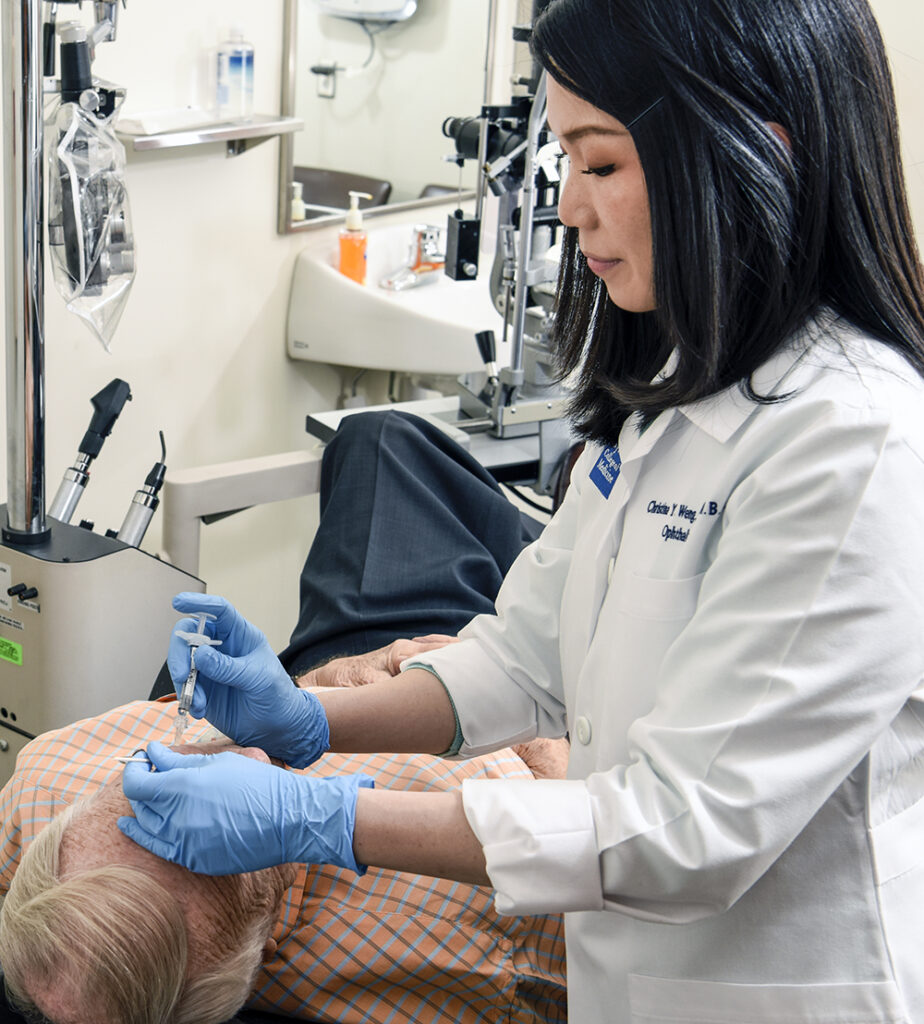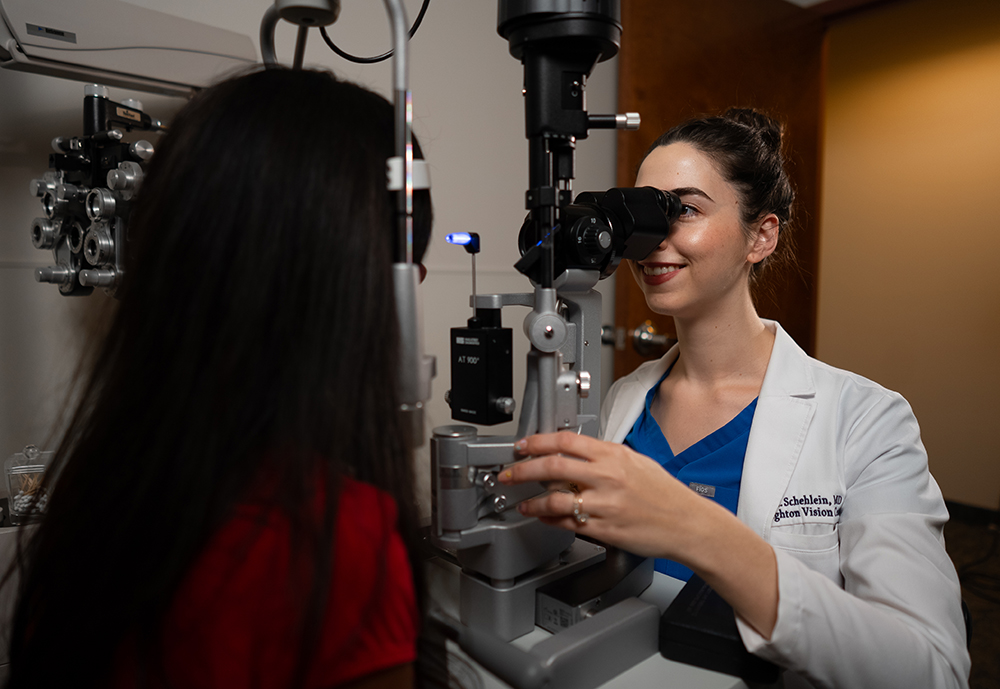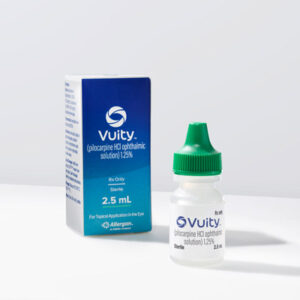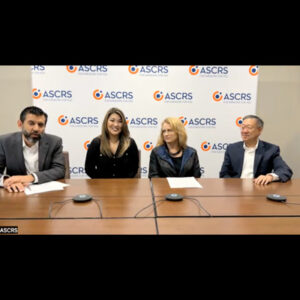Glaucoma
Spring 2024
by Ellen Stodola
Editorial Co-Director

Source: Christina Y. Weng, MD, MBA/Credit: Agapito Sanchez, Jr.
Anti-VEGF intravitreal injections (IVI) may have some effect on the success of glaucoma procedures, and both retina specialist, Christina Weng, MD, MBA, and glaucoma specialist, Emily Schehlein, MD, agree that this is situation dependent on the patient with various scenarios and pathologies.
Dr. Weng highlighted three specific situations where there could be a relation between injections and glaucoma procedures.
First, she brought up the ongoing debate regarding whether or not intravitreal injections impact IOP long term. “We know that in the short term, all intravitreal injections transiently elevate the IOP to the 30–40 mm Hg range, but for most patients, this will self-resolve within 30–60 minutes,” she said. “That being said, there is some literature suggesting that recurrent induced spikes could lead to persistent IOP elevation, especially in patients with glaucoma.1 So theoretically, this could counteract the effect of a procedure like MIGS, but additional research is needed.”
Additionally, approximately one-third of patients injected with intravitreal steroids will experience a significant rise in IOP approximately 6–8 weeks later, so this should always be monitored closely. She said it is important to remember that, in general, there is no definitive evidence to support that intravitreal injections cause glaucoma or negatively impact the success of glaucoma procedures.2,3
Dr. Schehlein echoed some of Dr. Weng’s observations regarding transient increase in IOP with IVIs, conflicts in the literature, and the active research in this area. Patients with glaucoma are more likely to develop an IOP spike than are patients without glaucoma, she said, adding that a study by Good et al. found that 33% of glaucoma patients compared to 3.1% of non-glaucoma patients (p<0.001) had an IOP spike following injection.4 While the increase in IOP with a spike from IVI is usually transient, Dr. Schehlein noted that some studies have shown long-term sustained IOP elevation can occur and lead to the patient requiring glaucoma surgery.5,6
Dr. Weng also mentioned that there are certain indications for glaucoma surgery, such as neovascular glaucoma, where intravitreal injections may actually improve procedural success.7 “Because steroids and anti-VEGF suppress inflammation and neovascularization, their effects on patient pathology and perioperative fibrosis could theoretically be beneficial, although this remains unproven,” she said.
Finally, she noted concerns with the actual injection procedure. “I typically avoid giving intravitreal injections within the first few days following a glaucoma surgery,” she said. It is also important to avoid injecting through involved areas such as a tube shunt plate or the bleb as this could result in erosion and ultimately failure.8
Dr. Schehlein added that anti-VEGF injections have been linked to higher rates of recurrent glaucoma tube erosions in patients with age-related macular degeneration (AMD).9 She agrees that it is critical to inject the medication away from the tube shunt or trabeculectomy and take care with inserting and removing the eyelid speculum. “All patients, but especially glaucoma patients with a history of incisional surgery, should be instructed not to touch or rub their eye following an injection.”

Source: Emily Schehlein, MD
She noted that other studies suggest that higher postoperative IVIs in incisional glaucoma surgery may improve outcomes.
“A study by Chang et al. found that >7 IVIs after traditional glaucoma surgery was associated with improved success (IOP reduction ≥20% with 5<IOP≤ 21 mm Hg). All patients had received at least 1 IVI prior to their glaucoma surgery,” she said. “The authors noted that the group who received postoperative IVIs had more diabetic retinopathy and retinal vascular occlusions, but both groups had similar rates of NVG (where IVIs have a therapeutic effect).”7 The effect of intravitreal injections on the success of MIGS is not well studied, Dr. Schehlein added. However, MIGS procedures can be used to treat persistent IOP elevation related to intravitreal injections.
“I would also note that glaucoma patients tend to have significant ocular irritation and ocular surface issues if they are taking topical medications,” she said. “The betadine prep used during IVI may further irritate the ocular surface, however, it is unlikely that this would affect any pre-existing glaucoma surgeries done on the eye.”
In terms of whether intravitreal injections cause glaucoma to progress more quickly, Dr. Weng said the jury is still out. “There have been some studies suggesting that recurrent intravitreal injections may hasten progression of mean deviation,” she said. But she added that these studies are often smaller, retrospective analyses that may have confounding factors.10,11
“While we work to discern whether or not a true association exists, it is important to monitor IOP closely in all patients receiving injections, especially in those with glaucoma or a susceptibility to glaucoma,” she said.
Dr. Schehlein agreed that this is an area of active research and pointed out several studies which have shown that the total number of injections is associated with an increased risk of elevated IOP, possibly due to decreased outflow facility, the exact mechanism of which is currently unknown and is likely multifactorial.12,13 A study from Eadie et al. found that 7 or more injections of bevacizumab were associated with a higher annual risk of glaucoma surgery.6 “It is possible that the frequency of injections impacts the need for glaucoma procedures, however, the data is minimal,” she said. “One study found that almost 9% of patients undergoing treat and extend with aflibercept and ranibizumab had a sustained intraocular pressure rise.14 However, it is unclear if treating and extending will decrease or prevent chronic elevations in IOP or if it is a cumulative effect of lifetime injections.”
Dr. Weng said it’s also unclear if the frequency of injections has an impact. “Obviously, if a true relationship exists between injections and persistent IOP spikes/glaucoma progression, then those receiving injections at a greater frequency would be at greater risk. It’s an area of active investigation,” she said.
To help reduce potential risk to glaucoma patients having intravitreal injections, Dr. Weng said that pre-injection IOP should be noted and tracked over time for all patients. “For patients with glaucoma or who are susceptible to glaucoma, the retina specialist could consider performing an anterior chamber paracentesis immediately before or following the injection,” she said. “Injecting more slowly has been suggested as a beneficial modification by some but lacks evidence at this time. Prescribing IOP-lowering drops to be used afterward is another option.” Dr. Weng noted that she rarely takes these steps personally but said that she always makes sure that her patients with glaucoma are actively being followed for their condition and suggests having a low threshold to directly reach out to the glaucoma specialist.
“Research shows that higher frequency of intravitreal injections may impact the need for glaucoma medication use and glaucoma surgery.6,15 Therefore, patients should routinely have their pressure checked whenever they present for an injection to monitor for IOP spikes and trends over time,” she said. Glaucoma patients should also be monitored with OCT and visual field testing with a glaucoma specialist.
Dr. Schehlein said that IOP spikes should be prevented in patients with advanced glaucomatous disease, especially as large IOP fluctuations in these cases may worsen disease. “In patients with advanced disease, we know that repeated IOP fluctuations may worsen glaucoma.11,16 In an advanced glaucoma patient newly requiring IVI for neovascular AMD with demonstrated IOP spikes following injection, I am proactive in preventing progression,” she said. “Sometimes this will mean adding an additional drop (as this has been known to decrease post-IVI IOP spikes), but if the IOP elevation is sustained or the fluctuation is significant, I will also talk to patients about the risks and benefits of pursuing a minimally invasive glaucoma surgery to decrease IOP fluctuations and lower IOP in the long term.17 In the case of glaucomatous progression in any patient, I will consider both minimally invasive and incisional surgery as an option to reduce IOP.”
While there are not many other complications associated with performing glaucoma procedures in patients who receive intravitreal injections, Dr. Weng did note the possibility of zonulopathy. “In those with an extensive history of intravitreal injections, because some glaucoma procedures nowadays are combined with cataract surgery, the surgeon should be aware of potential loss of zonular integrity,” she said. “One large registry study from Sweden found a 1.45 odds ratio for cataract surgery complications among patients with a history of intravitreal injections compared to those with none.”18
There have been recent advancements in drugs available in the retina space, as well as drugs being used in higher doses. It’s important to consider and monitor the impacts that these may have as they are being used and studied more.
In 2023, the first two drugs for the treatment of geographic atrophy (GA) were approved by the FDA. These are complement inhibitors given as intravitreal injections either every month or every other month, Dr. Weng said. “Because of this frequency, along with the fact that the drug volume is 0.1 cc (double the typical injection volume), it is important to remain vigilant for any post-marketing adverse effects that may emerge,” she said. “The rate of IOP rise reported in the pivotal trials for pegcetacoplan and avacincaptad pegol ranged from 2–9% but were thought to be related to the injection procedure rather than the drug itself, and the majority were transient and self-resolved.”19
Dr. Weng added that some recently-approved and investigational drugs are administered in a greater volume than what has typically been injected. “High-dose aflibercept is a four-fold dose of standard aflibercept delivered in a 0.07 cc volume,” she said. “Given concerns for possible effects on IOP by these drugs and others, some retina specialists are applying pressure to the globe pre-injection to potentially prevent post-injection spikes, although the benefits of doing this are unproven.” She added that it will be important for retina specialists to monitor all patients’ IOP over time and work closely with their glaucoma colleagues as more is learned about the relationship between intravitreal injections and glaucoma.
Dr. Schehlein said the effect on intraocular pressure after intravitreal injections occurs in two phases. First is the initial IOP spike from additional fluid injected into the eye, which is typically transient and resolves. However, patients can undergo a more chronic form of IOP elevation over time with multiple injections. “Newer treatment options for dry AMD/GA, which inhibit the complement system, are administered very similarly to current anti-VEGF IVIs and will be familiar to ophthalmologists who perform these injections,” she said. “Therefore, it is very likely that a subset of patients will undergo a transient IOP spike following injection, as shown in clinical trials.” She added that there is little data on the long-term effects of these medications, so it is important to monitor these patients by checking the intraocular pressure at each injection and clinic visits.17,20
“With these newer medications, the current guidelines are to inject them monthly or bi-monthly, and for many patients, the duration is indefinite,” Dr. Schehlein said. “As there is some data that increased number of injections can increase the risk of glaucoma surgery and the long-term effect of this new medication on intraocular pressure is unknown, clinicians should consistently monitor their patients’ intraocular pressure and proceed with caution in patients with advanced glaucoma. It is worth considering if glaucoma patients starting on these new medications should have glaucoma testing more frequently or if patients with a strong family history of glaucoma, glaucoma suspect, or ocular hypertension should undergo periodic baseline testing while receiving these newer types of injections.” Based on early data and experience, Dr. Schehlein’s practice is to monitor intraocular pressure closely, especially in moderate to advanced glaucoma patients, with a low threshold to repeat testing sooner and add treatment, laser, or surgery if the pressure is rising. She added that a side effect of these new IVIs for GA and dry AMD is anterior chamber inflammation, which glaucoma specialists should be on the lookout for during regular exams.
About the physicians
Emily Schehlein, MD
Brighton Vision Center
Brighton, Michigan
Christina Y. Weng, MD, MBA
Professor of Ophthalmology
Fellowship Program Director, Vitreoretinal Diseases & Surgery
Baylor College of Medicine
Houston, Texas
References
- Shah SM, al. Risk, prevalence, and progression of glaucoma in eyes with age-related macular degeneration treated with intravitreal anti-vascular endothelial growth factor injections. Am J Ophthalmol. 2022;243:98–108.
- Islam YFK, et al. Glaucoma drainage device erosions in patients receiving anti-vascular endothelial growth factor therapy for diabetic retinopathy. Clin Ophthalmol. 2022;16:3681–3687.
- de Vries VA, et al. The effects of intravitreal injections on intraocular pressure and retinal nerve fiber layer: a systematic review and meta-analysis. Sci Rep. 2020;10:13248.
- Good TJ, et al. Sustained elevation of intraocular pressure after intravitreal injections of anti-VEGF agents. Br J Ophthalmol. 2011;95:1111–1114.
- Bakri SJ, et al. Intraocular pressure in eyes receiving monthly ranibizumab in 2 pivotalage-related macular degeneration clinical trials. Ophthalmology. 2014;121:1102–1108.
- Eadie BD, et al. Association of repeated intravitreous bevacizumab injections with risk for glaucoma surgery. JAMA Ophthalmol. 2017;135:363–368.
- Chang EK, et al. Effects of postoperative intravitreal injections on outcomes of traditional glaucoma surgery in patients with preoperative intravitreal injections. Ophthalmol Glaucoma. 2022;5:219–228.
- Lam LA, et al. Intravitreal injection therapy: current techniques and supplemental services. J Vitreoretin Dis. 2021;5:438–447.
- Liu KC, et al. Recurrent tube erosions with anti-vascular endothelial growth factor therapy in patients with age-related macular degeneration. Ophthalmol Glaucoma. 2020;3:295–300.
- Pirinen I, et al. Glaucoma progression in patients receiving intravitreal anti-VEGF treatment for neovascular age-related macular degeneration. Acta Ophthalmol. 2023;101:261–265.
- Du J, et al. Effects of intravitreal anti-VEGF therapy on glaucoma-like progression in susceptible eyes. J Glaucoma. 2019;28:1035–1040.
- Hoang QV, et al. Effect on intraocular pressure in patients receiving unilateral intravitreal anti-vascular endothelial growth factor injections. Ophthalmology. 2012;119:321–326.
- Wen JC, et al. Intravitreal anti-VEGF injections reduce aqueous outflow facility in patients with neovascular age-related macular degeneration. Invest Ophthalmol Vis Sci. 2017;58:1893–1898.
- Bilgic A, et al. Sustained intraocular pressure rise after the treat and extend regimen at 3 years: aflibercept versus ranibizumab. J Ophthalmol. 2020;2020:7462098.
- Cui QN, et al. Repeated intravitreal injections of antivascular endothelial growth factors and risk of intraocular pressure medication use. Graefe’s Arch Clin Exp Ophthalmol. 2019;257:1931–1939.
- Matlach J, et al. Investigation of intraocular pressure fluctuation as a risk factor of glaucoma progression. Clin Ophthalmol. 2018;13:9–16.
- El Chehab H, et al. Effect of topical pressure-lowering medication on prevention of intraocular pressure spikes after intravitreal injection. Eur J Ophthalmol. 2013;23:277–283.
- Hård Af Segerstad P. Risk model for intraoperative complication during cataract surgery based on data from 900,000 eyes: previous intravitreal injection is a risk factor. Br J Ophthalmol. 2022;106:1373–1379.
- Khanani AM, et al. Efficacy and safety of avacincaptad pegol in patients with geographic atrophy (GATHER2): 12-month results from a randomised, double-masked, phase 3 trial. Lancet. 2023;402:1449–1458.
- Jaffe GJ, et al. C5 inhibitor avacincaptad pegol for geographic atrophy due to age-related macular degeneration: a randomized pivotal phase 2/3 trial. Ophthalmology. 2021;128:576–586.
Relevant disclosures
Schehlein: Perceptron Health, Glaukos, Allergan
Weng: AGTC, Allergan/Abbvie, Alcon, Alimera Sciences, Apellis Pharmaceuticals, Iveric Bio, Novartis, REGENXBIO, Regeneron, DORC, DRCR Retina Network, Genentech, EyePoint, Springer Publishers
Contact
Schehlein: emschehlein@gmail.com
Weng: Christina.Weng@bcm.edu



